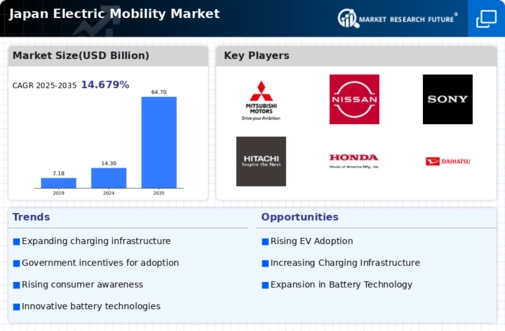Rising Environmental Awareness
The electric mobility market in Japan is experiencing a notable surge in demand, driven by increasing environmental consciousness among consumers. As awareness of climate change and air pollution grows, individuals are more inclined to adopt eco-friendly transportation options. This shift is reflected in a 2025 survey indicating that approximately 70% of Japanese consumers prioritize sustainability when choosing vehicles. Consequently, automakers are responding by expanding their electric vehicle (EV) offerings, which is likely to enhance the electric mobility market. Furthermore, the Japanese government has set ambitious targets to reduce greenhouse gas emissions, aiming for a 46% reduction by 2030. This regulatory framework further supports the transition to electric mobility, as consumers seek to align their choices with national sustainability goals.
Advancements in Charging Technology
Technological innovations in charging infrastructure are playing a pivotal role in the growth of the electric mobility market in Japan. The introduction of ultra-fast charging stations, capable of replenishing EV batteries in under 30 minutes, is significantly enhancing the convenience of electric vehicle ownership. As of November 2025, Japan boasts over 30,000 public charging points, a figure that has increased by 25% since 2023. This expansion not only alleviates range anxiety among potential EV buyers but also encourages existing owners to utilize their vehicles more frequently. Moreover, the integration of smart charging solutions, which optimize energy use based on grid demand, is likely to further bolster the electric mobility market. These advancements suggest a future where charging becomes as seamless as refueling traditional vehicles.
Corporate Sustainability Initiatives
The electric mobility market in Japan is increasingly influenced by corporate sustainability initiatives as businesses recognize the importance of reducing their carbon footprints. Many corporations are adopting electric fleets to align with their environmental goals, which is likely to drive demand for electric vehicles. A recent report indicates that over 40% of Japanese companies plan to transition to electric vehicles by 2026. This trend is not only beneficial for the environment but also enhances corporate image and competitiveness. Furthermore, partnerships between automakers and corporations are emerging, facilitating the development of tailored electric mobility solutions. As businesses invest in sustainable practices, the electric mobility market is expected to expand, reflecting a broader societal shift towards sustainability.
Urbanization and Changing Mobility Patterns
The electric mobility market in Japan is being shaped by rapid urbanization and evolving mobility patterns. As urban areas expand, the demand for efficient and sustainable transportation solutions is increasing. In 2025, urban populations in Japan are projected to account for over 90% of the total population, leading to heightened congestion and pollution concerns. Consequently, city planners are prioritizing electric mobility solutions, such as e-bikes and electric buses, to address these challenges. This shift is likely to create new opportunities for electric vehicle manufacturers and service providers. Additionally, the rise of shared mobility services, including ride-sharing and car-sharing platforms, is expected to further integrate electric vehicles into daily transportation, thereby enhancing the overall appeal of the electric mobility market.
Government Support for Research and Development
The electric mobility market in Japan is significantly influenced by government initiatives aimed at fostering research and development in electric vehicle technologies. The Japanese government has allocated approximately $1 billion for R&D projects focused on battery efficiency and vehicle performance. This investment is expected to yield breakthroughs that could enhance the range and affordability of electric vehicles. Furthermore, collaboration between public institutions and private companies is likely to accelerate innovation in the sector. As a result, the electric mobility market may witness a surge in new models equipped with advanced features, appealing to a broader consumer base. This proactive approach by the government indicates a commitment to establishing Japan as a leader in electric mobility technology.























Leave a Comment